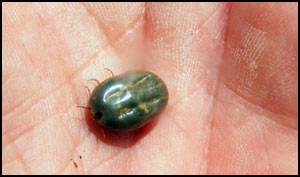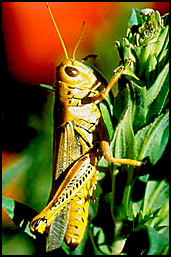HEALTH & NUTRITION...
Texas Groups Meet
to Discuss Tick Fever

The fever tick is a major concern to the livestock and wildlife industry. (TEXAS ANIMAL HEALTH COMMISSION PHOTO BY CARLA EVERETT)
Meeting brings together cattle industry groups to discuss prevention options.
Representatives from Texas' cattle industry recently discussed future research and educational partnerships related to fever ticks at a summit hosted by the Texas AgriLife Extension Service.
The fever tick is a major concern to the livestock and wildlife industry, said Tom Hairgrove, livestock systems program coordinator with AgriLife Extension Service and Texas Veterinary Medical Diagnostic Laboratory. It can carry and transmit Babesia, a blood parasite that can kill adult cattle. Other hosts for the fever tick are horses, deer, elk and other deer species. Read more.

Bob Larson
Vet Link
Control Lice
Every winter, producers must be on the lookout for lice infestations in their cattle herds. Lice thrive at normal skin temperature, but during spring and summer the skin temperature may go well over 100° F, which is warmer than lice prefer for egg production. Because of thick winter hair coats and cooler temperatures, infestations are usually heavier in late winter and early spring.
Read more.
Anti-infectives’ Role in Healing
Anti-infectives, properly used, can play a part in assuring animal health and well-being.
Producers strive to provide a safe and high-quality food supply and, when necessary, appropriate use of anti-infectives is a vital part of assuring animal health and well-being. When dealing with costly diseases like bovine respiratory disease (BRD), it is important that producers understand the healing process and the science behind the medications they're using as part of that process. Read more.
Calf Scours Caused By a Variety of Pathogens
One of the reasons why calf scours is such a challenging disease for producers is that it can be caused by a combination of two or more pathogens.
"There are four major pathogens that cause calf scours, and a host of minor ones," said Jerry Olson, senior veterinarian with Pfizer Animal Health. "In most cases, more than one of the causative agents is involved in clinical scours." Read more.

Rick Rasby
Ridin’ Herd
Testing forages for quality makes cents
Forages are the primary energy source for beef cows. From a forage standpoint, as plants mature, fiber increases. Fiber is less digestible than other plant parts, and fiber digestibility declines as plants mature. These factors cause the concentration of energy in plants to decline as maturity advances. In addition, as plants mature, the increase in fiber and bulkiness reduces the amount of the forage an animal can consume. Read more.
Doppler Helps Scientists
Understand Fescue Toxicosis
Weather technology used to help study toxins.
Doppler technology — the very same technology used by meteorologists to track thunderstorms — is being used by Agricultural Research Service (ARS) scientists to better understand the rate at which fescue toxicosis restricts blood flow in cattle. Read more.

ARS researchers have discovered that grasshoppers can transmit vesicular stomatitis virus from rangeland plants to livestock. PHOTO COURTESY OF WHITNEY CRANSHAW, COLORADO STATE UNIVERSITY, BUGWOOD.ORG.
Grasshoppers Can
Transmit Virus to Livestock
Study is the first to demonstrate stability of virus on
rangeland
plant surfaces.
Rangeland plants may be harboring a virus that grasshoppers are transmitting to cattle, horses and other hoofed mammals, according to a published research study by Agricultural Research Service (ARS) scientists.
A recent outbreak of vesicular stomatitis virus (VSV) in the southwest United States has disrupted rodeos and prompted quarantines. VSV is a viral disease that causes sporadic outbreaks in the United States, most recently in 2006. Read more.
Climate and Disease
Researchers look at how climate can predict changes for
parasite- and vector-induced animal diseases.
Climate change could have a major influence on animal health, both directly and indirectly, by affecting the parasites and vectors that spread diseases, according to Eric Hoberg, an Agricultural Research Service (ARS) zoologist at the agency's Henry A. Wallace Beltsville Agricultural Research Center in Beltsville, Md. Hoberg is chief curator of the U.S. National Parasite Collection.
Climate change can alter an animal's relationship with parasites and vectors. These changes can influence where parasites and vectors thrive, making certain geographical regions more or less amenable to them. Climate change can also alter when and for how long parasites and vectors pose a threat to agricultural animals. Climate can determine how pathogens are distributed, transmitted and evolve, and can influence the factors associated with emerging disease and how animals respond to those diseases. Significant environmental changes have been well-documented in recent decades, and some of these changes are causing trouble for livestock. Read more.
Cattle Diseases: Common Conditions/Terms
Click here for a list of common conditions and terms related to beef cattle diseases, such as anaplasmosis, brucellosis, BVD, E. coli, IBR and others.
[Click here to go to the top of the page.]





